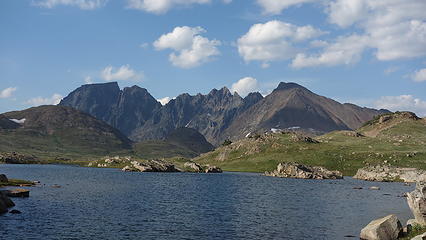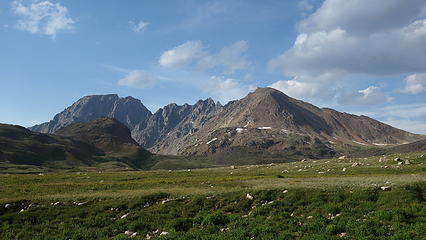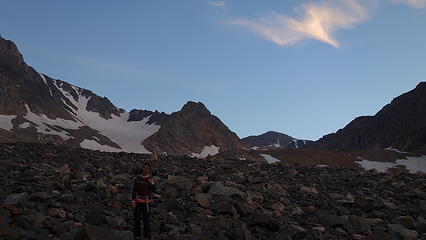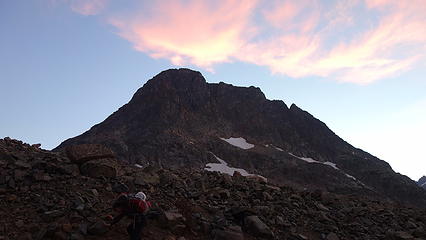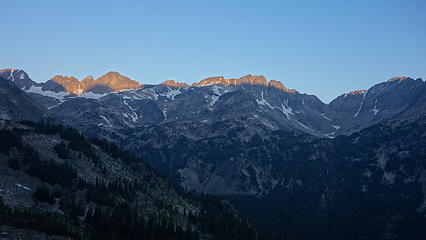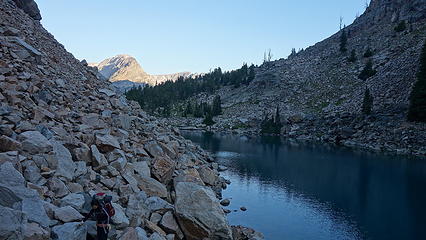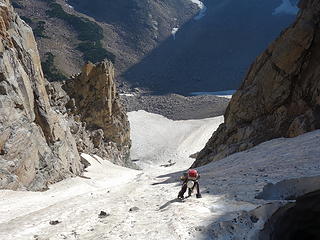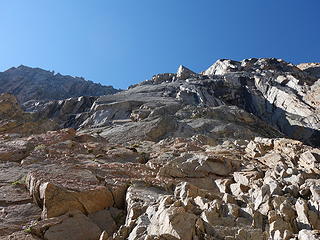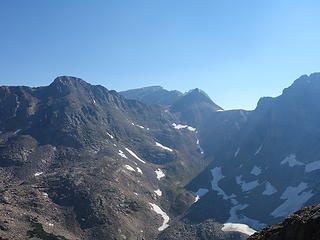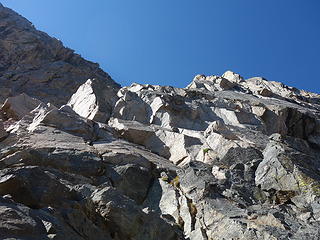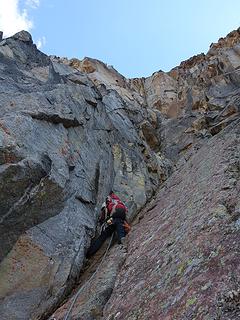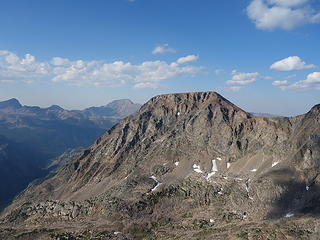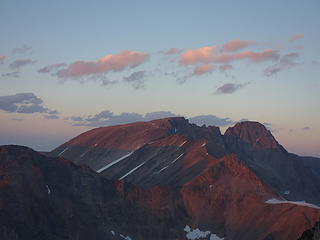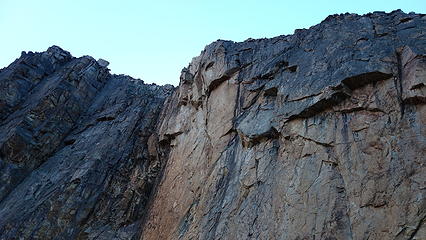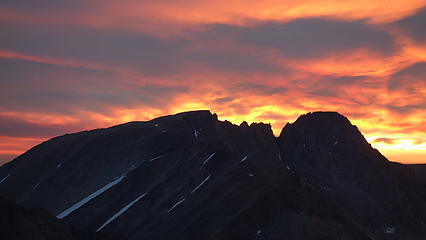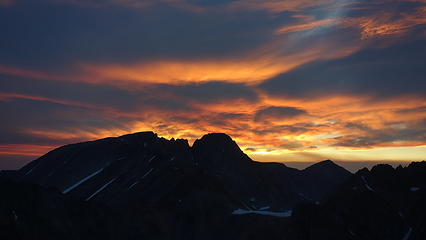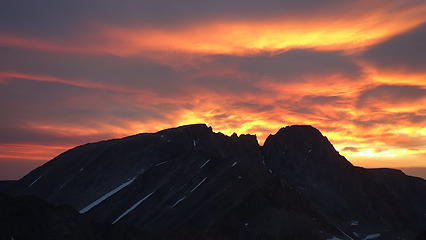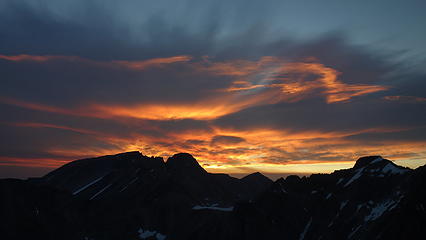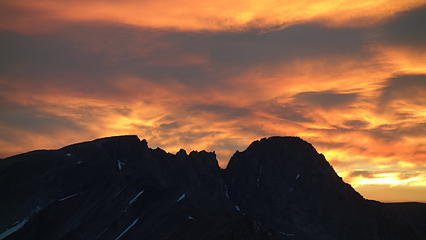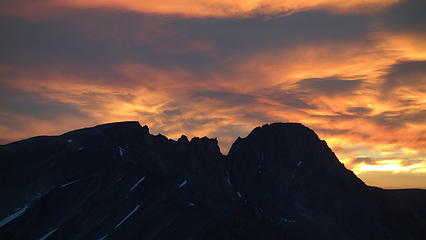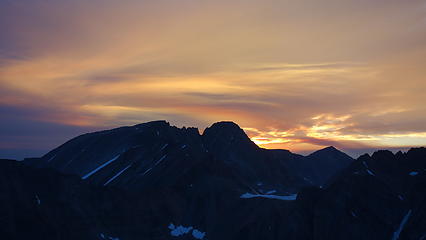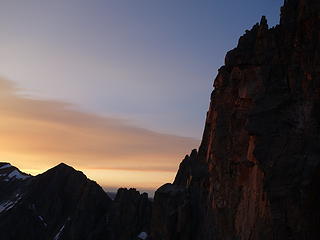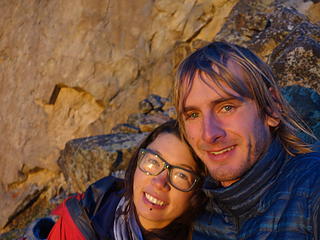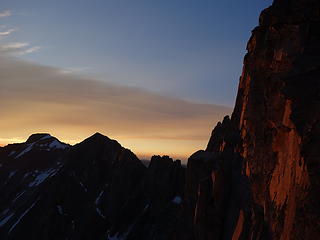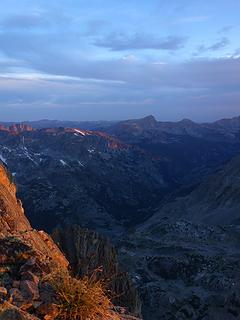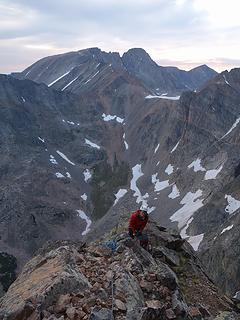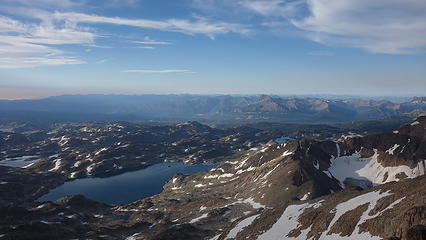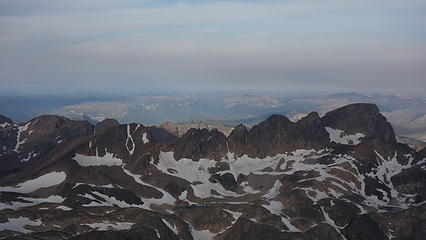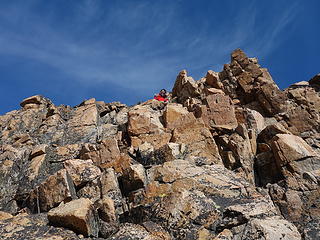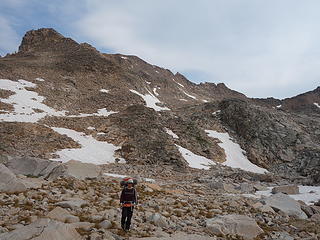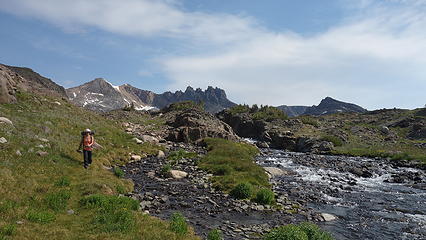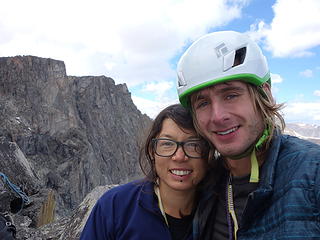glacier peak - 12,340' - Catch a Sunrise class 5.9
august 2017
Overview
Glacier Peak in the Montana Beartooth Mountains is the westernmost 12,000 foot peak and dominates the western margin of the range. This peak has fantastic technical routes on its north face, including the Beckey Couloir which cuts right to the summit through the face for over 2000 feet. The south face is relatively gentle and allows for an easy ascent from the Aero Lakes. The traverse to Mount Villard can also offer some moderate climbing. Views in all directions are stunning and the Cathedral Spires will stare you right in the face to the southeast.
There are many peaks named Glacier Peak around the world it almost feels like it may be the most common peak name, up there with Grizzly Peak and Bald Mountain. Naturally, it is unknown why this peak was given the name "Glacier Peak" but it most likely has to do with some kind of glacier carving work. Since the north face is so dramatic it may be the reason. Imagine glaciers completely filling all the valleys you see in the Beartooths all the way to the elevation of the current summit plateaus of all the peaks. That's ice coverage exceeding 2000 feet think in many places! Today, the Hidden Glacier flanks the base of the north face and it's aptly named as it really is hard to see.

Getting There
The standard way to approach Glacier Peak is from the south where an ascent of the Class 2 south slopes can be made. Use the Aero Lakes trailhead to access the area.
Lower Trailhead
From the tiny town of Cooke City, six miles from the northeast entrance to Yellowstone National Park, head east on US Highway 212 for 1.6 miles to the Lulu Pass Road. Turn left on this good dirt road and measure from this point. Go 1.1 miles to a 3 way fork and continue on the middle fork. Stay right at 1.8 miles and reach the signed Goose Lake junction after 2.4 miles. Do not continue straight towards Goose Lake as this quickly becomes a high clearance 4WD road but instead park off the road at this large intersection. If you have a 4WD vehicle or a tough passenger car with good clearance you can continue to the trailhead by taking a very sharp right turn on a small side road. Follow this rutted road for 0.3 miles to its end at 8,850 feet at an old mining cabin and a slough of mining ruins. You can camp here but the grizzly bears have been known to be a problem in this area.
Upper Trailhead
If you want to shorten your approach a little you can continue straight at the large Goose Lake intersection, passing by Mud and Round Lakes to a point 0.3 mile past Round Lake at an elevation of 9,420 feet. From here a switchbacking trail heads east downhill for 1 mile and meets the main Aero Lakes trail just to the north of Lady of the Lake at 9,150 feet.
Approach
From the lower trailhead, begin by crossing the creek just to the right of the old cabin (which was loaded with books, a stove, cots and all the newspapers you can dream of). Follow the trail to the northeast for 1.5 miles to the south end of Lady of the Lake to a signed junction and turn left. Continue on the nice trail around the west side of the lake for another mile to a second junction where the trail that descends from the upper trailhead meets the main trail. Stay straight and continue 1.8 miles to a third junction. Cross Star Creek enroute and take a right heading up the trail to Aero Lakes. Reach Lower Aero Lake at 10,000 feet after another 1.1 miles, a total of 4.4 miles from the lower trailhead. Fantastic camping can be found here. You can also continue northeast around Lower Aero Lake to the upper lake with even better camping and view with more solitude.
Route Options
South Slopes - Class 2
From Upper Aero Lake, head around the north shores of both lakes and continue north on talus or snow depending on the season aiming for the gentle south slopes and hike up directly to the summit, about 2,200 feet of elevation gain over the course of a couple miles. The views from the summit are breathtaking and don't forget to peer over the north face while up there!
North Face "Beckey Couloir" - Class 5.7, Steep Snow/Ice
Not only is this route very difficult with very steep snow and ice nearing 60 degrees in steepness with up to 5 pitches of 5th class rock climbing, it is difficult to access. It was first climbed by Fred Beckey in the summer of 1965. Likely the best place to approach this face is from Goose Lake since the wilderness boundary takes a large jog to the north allowing for vehicular travel to get closer to the highest peaks. A nice trail heads northeast for 3 miles from the wilderness boundary just south of Goose Lake to the 10,650 foot saddle between Iceberg Peak and Sawtooth Mountain, where the infamous Grasshopper Glacier flanks the north side of this saddle. If you look closely you might see some grasshoppers in the ice. You can descend the Grasshopper Glacier and traverse around the upper end of the West Rosebud Creek drainage and round the west face of Glacier Peak at the 9,500-10,000 foot level and reach the base of the Beckey Couloir at 10,000 feet, 2 miles from the saddle.
You can also approach the north face by continuing straight on the trail along Zimmer Creek for 1.4 miles to Zimmer Lake at 10,150 feet instead of heading to Aero Lakes. You can then head north on gentle slopes to the 10,800 foot saddle between Iceberg Peak and Mount Wilse and descend the Grasshopper Glacier meeting up with the route described above in the upper West Rosebud Creek drainage.
Another approach option takes you to the West Rosebud Trailhead and has you hike the long trail to the west end of Mystic Lake and round around the north side of Island Lake. However large amounts of bushwhacking are required past this point as you must ascend along West Rosebud Creek all the way to treeline, 2,500 feet above Island Lake where the forest is pretty thick.

Glacier/Villard Traverse - Class 3
This traverse is fairly straightforward. There is an unranked 12er called Hidden Lake Peak you must ascent over en-route between Glacier and Villard. There are a few short class 3 steps but nothing too technical. The rocks along this ridge are large and loose so exercise caution.

Catch-a-Sunrise - Class 5.9
This is a route I accidentely did with my close friend Elaine. It turned into a wild outing with an unplanned bivy. The words below describe the events and some beta from the 2018 AAJ if anyone else is adventurous enough to repeat.
Intending to have a nice, somewhat leisurely outing to complete my goal of climbing all the 12,000’ peaks in Montana, Elaine Kennedy and I set out to climb the prominent Beckey Couloir on the north face of Glacier Peak (12,340’) on August 17. [Editor’s note: Fred Beckey and Dave Beckstead made the first ascent of the face via the prominent central couloir and several rock pitches on the headwall. see AAJ 1965) What ensued was a bit more than we bargained for, all stemming from what could be the biggest navigation blunder in my menial climbing career.
The 11.5-mile approach originating just beyond Cooke City took us past Goose Lake, over Iceberg Pass and back down, and around the west face of Glacier Peak across a heinous rock glacier. The talus hopping in the Beartooths, as usual, didn’t disappoint. We bivied below the west face at the base of the rock glacier, and finished the approach to the base early the next morning.
Entering the small basin below the north face, I spotted an obvious couloir, assumed it was the Beckey, and we began climbing without giving it second thought. Booting up the perfect 55–60° degree snow, we made excellent time. However, as the couloir began to bend to the right after about 600’, the snow ended and we hit rock sooner than expected.
From here we trended up and left. Fourth-class rubble turned into 5.7 face, followed by two pitches in a dirty, wet chimney, then out left onto some runout 5.6 slab, followed by two more pitches of 5.7/5.8. I hadn’t brought my rock shoes to save weight, and I need to work on climbing in my bulky size 16 boots. At this point, we were pretty sure we were not on the Beckey.
We found ourselves in a somewhat improbable location where the only climbable way was a scary 5.8 rightward traverse with little pro. The following 70 meters of rubble-strewn 5.4 went quickly, but the crux was still above us.
Elaine took the lead and attempted to attain the top of a rib above and left of us. Everything left looked hard, so we continued up the easy ramp as far as possible, to where it curved into a dihedral. Unfortunately, multiple microwave-size blocks teetered on the brink of freefall. Elaine took a wicked fall here and was lucky to be unscathed—she's a tough girl. I climbed to where she fell and built an anchor, and after some TLC, we were both above the looseness without knocking anything down.
I searched for a way up the final 40 feet to easier ground and rounded a large boulder with some serious air. Amazingly, I found a bomber 5.8 hand crack. With darkness nearing, we did one more long 5.4 pitch and found a place to bivy. That night was magical, as we lay on a knife-edge ridge under clear skies with dazzling meteors. Throughout the night, I recalled past trips to this mountain range for which I have an enduring fondness.
The morning sunrise behind Granite was the perfect energizer, and we finished the climb with one class 4 pitch up the rib to the summit plateau. Upon summiting, I realized definitively we did a route nowhere near the Beckey Couloir, as we were way off to the west. We were ecstatic with our accomplishment, though, and probably still a bit scared, and we had a lot to talk about during the 10-mile hike back down the south slopes and past Aero Lakes.
After returning to civilization, we did some research and determined we had initially started up the Catch-a-Fire Couloir, which eventually ends at a notch in the ridge and has been skied several times. No one we spoke to seemed to have any knowledge of any summer climbing routes in the vicinity of the couloir. We named the route Catch-a-Sunrise (2,000’, III/IV 5.9 PG-13).
Map
Below is a map showing the routes on Glacier Peak:
RED: Goose Lake/Grasshopper Glacier Approach to the north and west faces
LIGHT BLUE: West Rosebud/Mystic Lake Approach to the north and west faces
PINK: Zimmer Lake/Wilse Pass Approach to the north and west faces
ORANGE: Aero Lakes Approach and South Slopes Route - Class 2
DARK BLUE: Beckey Couloir Route - Class 5.7 with 60 degree snow/ice
GREEN: Glacier Peak/Mount Villard Traverse - Class 3
Camping/Red Tape
The trailhead and first mile of the trail are within the National Forest however Aero Lakes and Glacier Peak lie within the Abasorka-Beartooth Wilderness. No motorized equipment is allowed. Please leave no trace.
Camping at Lower or Upper Aero Lake is all fantastic.
External Links
Weather Forecast
Absaroka-Beartooth Wilderness Info
Stupidly Insane Trip Report
trip report
This was an exceptionally memorable climb that I did with Elaine, which was her first trip into Montana's Beartooths. Myself; I have been coming to this mountain range many times since 2012, and have seen enough corners of it to hold my own against any of the local Montana Beartooth stompers, however this climb was exceptionally significant because it was on Glacier Peak. This was the last Montana 12er I had yet to summit, and I had been putting it off until the right time came where I could climb the North face Beckey Couloir Route. This is a rarely climbed route straight up the rugged north face of the mountain. I could have easily tagged its summit by walking up the talus from the Aero Lakes Basin, however I wanted this peak to be something more than that. Knowing the conditions dictating everything for this route, I had to find the perfect time, and as chance would have it, Elaine and I had that chance in mid August this year just a few days before the total solar eclipse (which we saw in Wyoming!). As an aside, for anyone wondering, yes I am still working on that Beartooth Guidebook. 
We had both just finished a successful climb of the East Ridge of the infamous Bears Tooth earlier in the week (see link above) and we were ready to tackle the main objective. The trip started on August 16th by driving up to the Goose Lake 4WD road from Cooke City and parking at the start of the 4WD road. It was a 4ish mile walk along the road to Goose Lake. We were hoping we would run into someone heading up willing to give us a lift but since that never happens, it didn't happen haha. Our late start of about 2:30pm also probably didn't help. We however hiked around the beautiful Goose Lake, and onward to the broad saddle between Iceberg and Sawtooth Peaks under beautiful sunny skies. Looking at Sawtooth Ridge from Goose Lake really inspired both of us to return one day to traverse that ridge.
At 5pm we reached the saddle, and I remembered the last time I was here on a quick solo venture to Iceberg Peak and to get a firsthand look at the west face of Glacier Peak. The wind forced us to continue the cross country walking over loose talus and the occasional snowfield east towards Glacier Peak. We passed alongside the stunning Iceberg Lake until we reached the point where we started descending steeply down loose scree onto the large rock glacier that extends off to the north of Mount Wilse. It was a long and mostly uneventful walk as the sun was setting into the boulder strewn valley at the base of Glacier Peaks west face. The ankle twisting loose rocks on the rock glacier was somewhat slow going, and I knew we would not be able to reach the base of the Beckey Couloir before dark, so I began looking for a place to sleep for the night.
The towers and monoliths that surrounded us in this valley were awe inspiring, with the added sunset effect really making the evening magical in an otherwise heinous walk, which now exceeded 10 miles. As my luck would have it though, right as dusk set in and headlights would have become mandatory, we got to the edge of the rock glacier, and shortly after dropping off found a beautiful little flat grassy meadow, with a small stream nearby that we could lay down for the night! This wasn't the first time this year that I got extremely lucky finding a place to camp right as total darkness was setting in.
To save weight on what we knew was going to be a carry-over, and since we each already had ice tools, crampons and big boots, we didn't bring a tent. We simply threw the pads and sleeping bags down on the grass (or sedge, as it is apparently properly called according to Elaine) and cooked a nice dinner and quickly went to bed. With the perfect weather, we couldn't resist stargazing and looking for meteors for quite some time that first night, and thinking endlessly about the climb that lie ahead. I admit I was a little nervous mainly because I had been waiting to do this climb for years. Little did I know I was about to make probably the worst navigational error I have ever made in my climbing career.
The next morning we started as soon as enough light broke the darkness of night, and continued hiking along the bottom of the west face, traversing the large talus fields until we could round the corner to the right and enter the basin below the north face. We hiked around a small tarn along the steepest part of the face below the northwest flank, and ascended once again until we reached a large snow couloir. It was roughly 8:30 in the morning when we reached the start of the couloir, and we took a nice snack break and switched into our mountaineering boots, put crampons on and layered appropriately. The climb was about to begin.
We started soloing up the snow, and actually both felt comfortable remaining solo until we reached the upper end of the steep couloir, which felt like it had a max steepness of about 60 degrees. For her first steep snow climb, Elaine did amazing and felt confident the whole way. I recall thinking the couloir ended rather quickly as it felt like we only ascended about 600 feet before we hit rock but I didn't think much of it. All I knew is I was looking for a rib that bisected the couloir and it was 5 pitches of rock up to 5.7 up this rib directly to the summit. Well, as we were standing in the small moat at the top end of the couloir we were in, I saw what looked like a rib heading just above us, but the couloir didn't extend to the left of it, only continued up to the right. I figured the left side finger had dried out and started scrambling steep and loose 4th class up this feature as Elaine carefully followed. After maybe 100 feet we reached a nice ledge system and traversed leftward until I hit a 5.7 rock section. We finally busted out the rope and cams and I led this short pitch in my boots to a "ready to explode" ledge just below a 5.8+ hand crack that I wasn't comfortable leading in my boots.
To save weight, I left my rock shoes thinking the route was only going to be 5.7, and just in case, Elaine brought hers, so she led up this 20 foot 5.8 crack and cut right into a large chimney. Since I didn't have any idea as to what each of the 5 pitches of the Beckey Couloir route entailed, I assumed we were on route, since the chimney wasn't too hard. Halfway up the chimney, Elaine made an anchor and belayed me up. She then continued up another pitch in the chimney to a huge ledge, which upon reaching myself, I really started to get confused. I still didn't know we were WAY off to the right of the actual Beckey Route, but upon looking up at how much more rock climbing we had to do, I was beginning to wonder.
So we decided that moving left looked better, and Elaine led another pitch up somewhat runout 5.6 slab to a ledge, then I led up a somewhat garbage pitch on loose 5.4 to another ledge. We were now 5 pitches up from where we started roped climbing, and no end in sight. Rather than worry about how we might be off route, I continued focusing on the task of safely getting up this face. Elaine continued up our 6th pitch on now more difficult 5.8 terrain with less pro. I was glad she brought her rock shoes and she led these pitches beautifully. As she started up a short 5.8 7th pitch, we started seeing considerably harder, slabby terrain above us, and she found herself in an alcove with nowhere to feasibly climb. I climbed up to her to scout out what lie ahead and it didn't look good. Up and left was impossible, and a delicate traverse to the right was the only feasible way. I took over leading, leaving my pack with Elaine and started making the traverse laterally to the right, where it appeared we could enter a long easier ramp system that would hopefully take us to an easier looking rib off above us that appeared to go towards the summit. Lots of speculation I know, but knowing we only had one option at the time we had to traverse right.
I managed to safely traverse across, but not without plenty of cursing, and make a good anchor. There wasn't much pro though so Elaine was rightfully hesitant to make the traverse knowing a fall would impose a large pendulum swing, especially doing it with two packs! I was able to talk her through it, despite not being able to see one another, however one move that required every bit of my long reach was very scary for her. I am amazed she pulled through.
Once we both got past the traverse, I led up a long 60 meter pitch up an easy 4th-low 5th ramp and kept a watchful eye on any climbable spots above up to our left. I was able to definitely confirm that the easier looking rib above and left of us would lead to the summit area, however we needed to get on that rib, which was 70 feet above us and looked improbable. We decided since we couldn't see what was at the very top of the easier ramp we were currently on, as it curved left, it would be best to go as high as we could and see what was up there. Elaine continued up a right facing dihedral in a seam along the base of the steep wall that blocked easy access to the rib above. It was easy until she entered that left curving area, where she continued to mention small car sized loose blocks. At this point I couldn't see her, and after she spent 15 minutes or so contemplating it she went for a move, then fell.
All I remember is hearing screams and watching her slide down the ramp on her pack popping two cams then stopping on her own (rope didn't end up weighted) as her pack got wedged into the dihedral she had climbed. Amazingly, she was ok despite taking a 30 foot fall, and after talking things through, she was able to calm down enough to build an anchor where she was, and allow me to go up and see what we were up against. When I got to the place she fell, I could see the large blocks she was mentioning, and found a spot to put one small nut and a 0.4 cam. That was going to have to do as I belayed her back up to me. I could see easier terrain and a ledge merely 20 feet above us, but that 20 feet was the scariest moment in both of our climbing careers. Since neither of us wanted to or was able to climb this section (mainly because we could not feasibly touch anything) I straddled the open book weighting the two pieces I placed, and with Elaine on belay, I pushed her up as high as I could until she could grab a solid hold above the two 7 foot long loose blocks. Thankfully she found something solid and was able to crawl onto the ledge just above. The scariest part of all this was that as this was all happening, I watched the nut I placed start to come loose, so as Elaine was midway up with huge rocks teetering right at my chest I also had to re-set that nut. This should have terrified me to absolutely no end, but I held my composure incredibly well...almost too well now that I look back.
With Elaine now on a good ledge, I climbed up to her, which was a solid 5.9+ when I wasn't able to touch anything along the seam of the open book we were in. It was even harder in boots. We took a nice rest here, and realized we were not out of it yet. Another 25 feet of vertical improbable terrain was left until we got to easier ground. I saw three seams above me, and none of them looked good or offered much pro, but around a bulge to our left looked like a potential route, so I left my pack with Elaine and led out stepping out over some serious air and around the bulge, and found a beautiful 20 foot 5.8 hand crack that I just told myself I will climb regardless as to what was on my feet. I mustered up the energy to basically pull up on just hand jams with next to no help from my feet since those huge boots were not jamming in any crack! It was right when I reached the top of this crack that I realized we were going to actually top out on this face. I let out a huge sigh of relief and walked back right to a point where I was directly above Elaine and pulled my pack up, then belayed her up. I was very thankful I remembered to take a few photos of the sunset because it was truly spectacular, especially with Granite Peak (Montanas highest) staring at us from across the valley.
Elaine continued on past me since I wasn't perched in the most comfortable of spots. It was quickly getting dark and I was really hoping we could get to the summit before dark. I led up one more pitch (now about 12 total), hoping this would be the last one, and I did reach the crest of the small rib we were looking up at all afternoon and was immediately blown away as to how suddenly it dropped off into a deep gash on a different part of the north face. It was very eerie coming up to this narrow, wildly exposed rib crest right as near darkness was setting in. Then I looked across this gash and saw another 200 feet of dead vertical rock silhouetted against the twilight and yelled out a loud "Oh sh##"
Then I looked to my right and saw the rib continued up on easy terrain, and was thanking the heavens lol and I continued until I ran out of rope, hoping I would find some kind of flat spot to bivy for the night. When the rope ran out I came to a spot on the rib that was at the very least flat, but not very big. I didnt take a very hard look at it yet and quickly belayed Elaine up this last pitch. When she arrived, it was too dark to see what remained of the climb, and upon further inspection, we agreed we could both fit in the spot we were in for the night. We doctored up the area a bit and made a spot long enough for me and a second spot right next to it just big enough for Elaine to fit. I built a small rock wall on my outer side to keep me from falling off the rib at night, secured our packs with a couple cams, and put down the sleeping bags (thank goodness we had them!).
We were not planning to spend a second night on this trip, as we originally were planning to climb up and over Glacier Peak and hike out the second day, so we didn't have any food to make. We both ate one clif bar from our snack reserves, and stared up at the starts for a long time, contemplating what we were doing. We were both thrilled and relieved to have mostly completed the route, and were confident there wouldn't be much more climbing to reach the summit. We gazed at the dark, moonless night sky contemplating life and admiring the stars. It was a crystal clear, warm and calm night...perched on a very narrow rib with huge drops to both sides of us. We were alone, free and in a state of euphoria. At this point I was nearly 100% sure we were doing a new route, and were walking on untouched ground. That was one of the best nights I have ever known, and made even more amazing to share with someone as amazing as Elaine.
To add to the incredible nature of our bivy, as the night waned, and twilight gazed over the mountains, we watched a sunrise for the ages right over Granite Peak. We could finally really enjoy the views that surround us, as we were too intently focused on the climb the day before. We emerged from our perch shortly after sunrise and packed up our gear, which I then led up just one more 4th class pitch which dumped me onto the summit plateau!! I couldn't believe it, and let out a scream of joy. Elaine came up and we congratulated one another, had a quick break and packed away the rope. I looked up to the left and saw easy class 2 boulders that led to what looked like the summit just 40 feet above us. However, when we saw that the summit was a 10 minute walk to the south, up an additional 200 feet, I was at that point 100% sure we did not do the Beckey Route, and more than likely put up what would be both of our first, first ascent. When we finally reached the summit, I saw the top of the Beckey Couloir, and the whole route leading down directly below us. Elaine commented something along the lines of "Matt, that route looks so much easier!" along with a few joking criticisms that I have no idea where I am going etc etc...after all it was my fault we climbed the wrong route. I simply assumed the first couloir we came across on the approach was the Beckey Couloir, but take note...that is NOT true. The Beckey Couloir is much, much wider and longer than the couloir at the bottom of the route we climbed.
My friend Vince from Bozeman pointed out after we returned from the climb that the couloir we climbed is called "Catch-a-Fire" Couloir, which had actually been skied some time ago, but after consulting with a few local climbers no one had known of the route we did above the couloir so we believe it's safe to claim this FA. In respect of whoever named that couloir before us, we named the route "Catch-a-Sunrise" to remember that gorgeous sunrise we witnessed from our bivy. See the topo below, and notice the much larger couloir well off to the left. THAT is the Beckey Couloir!
Back to the summit...I pulled out my bag of Oreos that I was saving for the summit, which was the only food I had left. We shared them and celebrated as I had finished my last Montana 12er in spectacular fashion. I knew we had a long walk out though, so after a 30 minute stay, and some awesome photos, we started down the south slopes towards Upper Aero Lake, and hiked all the way out and getting back to Bozeman in time to meet up with my friends Josh and Vince. Josh had taken a Greyhound over from WA to join us for the Eclipse in Wyoming, and we ate a nice dinner at Montana Ale Works. Shown below are photos we took from the summit and on the descent.



















